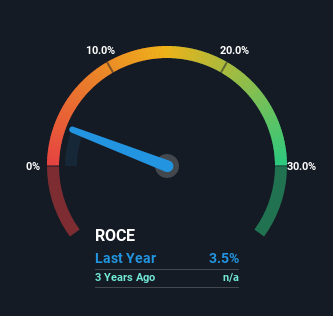- Australia
- /
- Professional Services
- /
- ASX:AQN
Some Investors May Be Worried About Aquirian's (ASX:AQN) Returns On Capital

There are a few key trends to look for if we want to identify the next multi-bagger. Amongst other things, we'll want to see two things; firstly, a growing return on capital employed (ROCE) and secondly, an expansion in the company's amount of capital employed. If you see this, it typically means it's a company with a great business model and plenty of profitable reinvestment opportunities. In light of that, when we looked at Aquirian (ASX:AQN) and its ROCE trend, we weren't exactly thrilled.
Understanding Return On Capital Employed (ROCE)
For those that aren't sure what ROCE is, it measures the amount of pre-tax profits a company can generate from the capital employed in its business. To calculate this metric for Aquirian, this is the formula:
Return on Capital Employed = Earnings Before Interest and Tax (EBIT) ÷ (Total Assets - Current Liabilities)
0.035 = AU$592k ÷ (AU$24m - AU$6.6m) (Based on the trailing twelve months to December 2022).
So, Aquirian has an ROCE of 3.5%. Ultimately, that's a low return and it under-performs the Professional Services industry average of 13%.
Check out our latest analysis for Aquirian

While the past is not representative of the future, it can be helpful to know how a company has performed historically, which is why we have this chart above. If you'd like to look at how Aquirian has performed in the past in other metrics, you can view this free graph of past earnings, revenue and cash flow.
What Can We Tell From Aquirian's ROCE Trend?
On the surface, the trend of ROCE at Aquirian doesn't inspire confidence. Around two years ago the returns on capital were 23%, but since then they've fallen to 3.5%. However, given capital employed and revenue have both increased it appears that the business is currently pursuing growth, at the consequence of short term returns. If these investments prove successful, this can bode very well for long term stock performance.
On a related note, Aquirian has decreased its current liabilities to 28% of total assets. That could partly explain why the ROCE has dropped. Effectively this means their suppliers or short-term creditors are funding less of the business, which reduces some elements of risk. Since the business is basically funding more of its operations with it's own money, you could argue this has made the business less efficient at generating ROCE.
In Conclusion...
Even though returns on capital have fallen in the short term, we find it promising that revenue and capital employed have both increased for Aquirian. These growth trends haven't led to growth returns though, since the stock has fallen 36% over the last year. As a result, we'd recommend researching this stock further to uncover what other fundamentals of the business can show us.
If you'd like to know more about Aquirian, we've spotted 4 warning signs, and 2 of them make us uncomfortable.
While Aquirian isn't earning the highest return, check out this free list of companies that are earning high returns on equity with solid balance sheets.
New: Manage All Your Stock Portfolios in One Place
We've created the ultimate portfolio companion for stock investors, and it's free.
• Connect an unlimited number of Portfolios and see your total in one currency
• Be alerted to new Warning Signs or Risks via email or mobile
• Track the Fair Value of your stocks
Have feedback on this article? Concerned about the content? Get in touch with us directly. Alternatively, email editorial-team (at) simplywallst.com.
This article by Simply Wall St is general in nature. We provide commentary based on historical data and analyst forecasts only using an unbiased methodology and our articles are not intended to be financial advice. It does not constitute a recommendation to buy or sell any stock, and does not take account of your objectives, or your financial situation. We aim to bring you long-term focused analysis driven by fundamental data. Note that our analysis may not factor in the latest price-sensitive company announcements or qualitative material. Simply Wall St has no position in any stocks mentioned.
About ASX:AQN
Aquirian
Provides equipment, workforce, technology products, and training solutions to the mining and resources industry in Australia.
Slight with imperfect balance sheet.
Market Insights
Community Narratives



